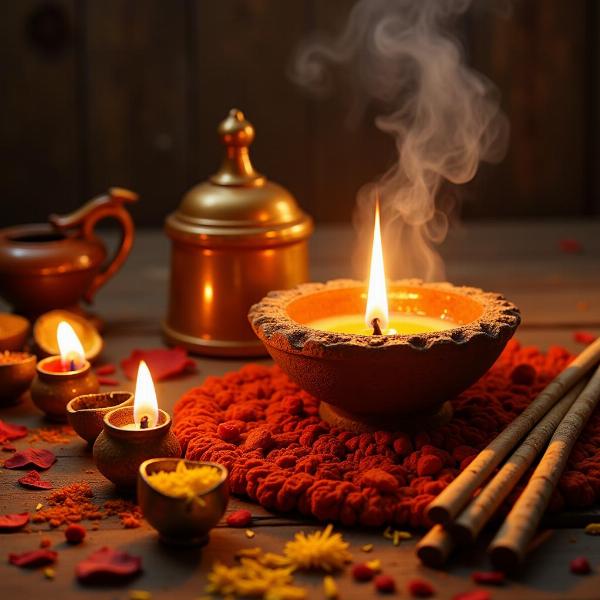Understanding the meaning of “sacred” in Hindi is crucial for anyone seeking to grasp the rich tapestry of Indian culture and spirituality. “Sacred” refers to something holy, revered, and dedicated to a divine being or purpose. This concept is deeply ingrained in Indian traditions, influencing everything from daily rituals to grand festivals. The Hindi language offers a variety of words to express this multifaceted concept, each with its own nuances and connotations.
Decoding “Sacred” in Hindi: Exploring Key Terms
Several Hindi words capture the essence of “sacred.” Let’s delve into some of the most prominent ones:
-
पवित्र (Pavitra): This is perhaps the most common and direct translation of “sacred.” It signifies purity, holiness, and freedom from defilement. Pavitra is often used to describe objects, places, and rituals associated with religious practices. Think of the Pavitra Ganga (Holy Ganges), revered as a sacred river.
-
पूज्य (Poojya): This term denotes something worthy of worship and reverence. It emphasizes the act of showing respect and devotion to something considered sacred. Poojya can be used for deities, religious leaders, and even elders.
-
पावन (Pavan): Similar to Pavitra, Pavan signifies purity and holiness. However, it also carries a sense of sanctification and the power to purify.
-
दिव्य (Divya): Divya translates to “divine” or “heavenly.” It implies a connection to the gods and a transcendental quality. Divya is often used to describe experiences, objects, or places that are considered otherworldly and sacred.
 Sacred Objects in Hinduism
Sacred Objects in Hinduism
The Significance of the Sacred in Indian Culture
The concept of the sacred permeates every aspect of Indian life. From the food we eat to the clothes we wear, from the way we greet each other to the festivals we celebrate, the sacred is interwoven into the fabric of our society.
Sacred Spaces: Temples and Beyond
Temples are perhaps the most obvious manifestation of the sacred in India. These are spaces dedicated to deities, where devotees come to worship and seek blessings. But sacred spaces aren’t limited to temples. Rivers, mountains, trees, and even specific corners of our homes can be considered sacred.
Sacred Rituals: Connecting with the Divine
Rituals play a crucial role in maintaining the sanctity of sacred spaces and objects. These rituals, often passed down through generations, create a tangible link between the human and the divine.
Sacred Texts: Sources of Wisdom and Guidance
Hinduism boasts a vast collection of sacred texts, including the Vedas, Upanishads, and Bhagavad Gita. These texts are revered as sources of divine knowledge and provide guidance on how to live a righteous life.
Sacred vs. Profane: Understanding the Dichotomy
The concept of the sacred is often contrasted with the profane, which refers to the ordinary, mundane, and non-religious aspects of life. This dichotomy is fundamental to understanding how Indians perceive the world around them.
What are some examples of sacred objects in Hinduism?
Sacred objects in Hinduism vary widely, but some common examples include statues of deities, the tulsi (holy basil) plant, the swastika symbol, and the Om symbol.
How does the concept of sacred influence daily life in India?
The concept of the sacred influences numerous aspects of daily life in India, including dietary restrictions, personal hygiene practices, social interactions, and family traditions.
Conclusion: Embracing the Sacred in Our Lives
Understanding the meaning of “sacred” in Hindi unlocks a deeper appreciation for Indian culture and spirituality. By recognizing the significance of pavitra, poojya, and other related terms, we can gain a richer understanding of the values and beliefs that shape the lives of millions of people. The concept of the sacred is a powerful force that connects us to something larger than ourselves and reminds us of the importance of reverence, respect, and devotion.
FAQ:
- What does the word “mandir” mean in Hindi? Mandir means “temple” and refers to a sacred place of worship.
- Is the cow considered sacred in Hinduism? Yes, the cow is highly revered in Hinduism and is often seen as a symbol of motherhood and nourishment.
- What is the significance of the tilak (mark on the forehead)? The tilak is a mark worn on the forehead, often during religious ceremonies, and signifies blessings and spiritual awakening.
- Are there any specific days considered sacred in Hinduism? Yes, numerous days are considered sacred, including festival days like Diwali and Holi, as well as days dedicated to specific deities.
- What are some common sacred chants in Hinduism? Common sacred chants include “Om,” “Hare Krishna,” and various mantras dedicated to different deities.
Meaning-Hindi.in offers professional translation services in Hindi and other languages. Specializing in business, legal, technical, website, educational, and urgent translations, our expert team delivers accurate and culturally sensitive language solutions. Need help bridging the language gap? Contact us at [email protected] or call +91 11-4502-7584. Meaning-Hindi.in is your trusted partner for all your translation needs.